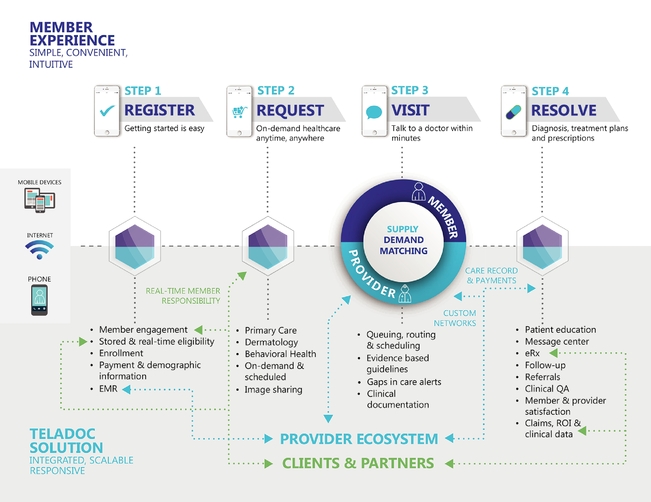Barriers and inefficiencies in the current U.S. healthcare system present market participants with three significant challenges:
- Consumers lack sufficient access to high-quality, cost-effective healthcare at appropriate sites of care while bearing an increasing share of costs;
- Employers and health plans lack a practical solution that reduces costs while enhancing healthcare access for beneficiaries and
- Providers need more flexibility to increase productivity by delivering care on their terms.
Market participants are increasingly unable to effectively and efficiently receive, deliver or administer healthcare. At the same time, the emergence of technology platforms solving massive structural challenges in other industries has highlighted the need for a similar solution in healthcare.
Teladoc saw it as a significant opportunity to solve these challenges through a trusted solution that matches consumer demand and physician supply in real-time while offering health plans and employers an attractive, cost-effective healthcare alternative for their beneficiaries.
Twenty years, Teladoc Health set on a path to transform healthcare to help all people live healthier lives. But as strategy enthusiasts, we decided to evaluate the business model of Teladoc and learn how Teladoc works and makes money. We have also done a competitor analysis for Teladoc. Let’s find out.
What is Teladoc? How does Teladoc work?
Teladoc Health, Inc. is a multinational telemedicine and virtual healthcare company headquartered in the United States. Primary services include telehealth, medical opinions, A.I. and analytics, telehealth devices, and licensable platform services.
In particular, Teladoc Health uses telephone and videoconferencing software and mobile apps to provide on-demand remote medical care. Teladoc was founded in 2002 in Dallas, Texas, by G. Byron Brooks, EE MD, and Michael Gorton.
Teladoc calls itself the oldest telemedicine company in the United States. The initial business model of Teladoc allowed patients to consult with state-licensed doctors at any time remotely. Companies paid a monthly fee for their employees to access the service, while patients paid a flat fee for each consultation, originally about $35 to $40.
Teladoc Health was founded and works on a simple yet revolutionary idea: everyone should have access to the best healthcare anywhere in the world on their terms. Today, Teladoc provides whole-person virtual care, including primary care, mental health, chronic condition management, and more.

Teladoc works on creating a unified and personalized consumer experience, developing technologies to connect patients and extend the reach of care providers, delivering the highest standard of clinical quality at every touchpoint, and enhancing health decisions and outcomes with intelligent data and actionable insights.
Teladoc claims it has the most extensive breadth of integrated whole-person products and services in the virtual care industry. Teladoc is capitalizing most recently on its combinations with Livongo Health, which significantly strengthened its chronic care management capabilities, and InTouch Technologies, which expanded its care delivery both inside and outside the hospital.
Altogether, this creates a well-defined opportunity for Teladoc to treat the whole person, from their mental healthcare to their physical healthcare and acute episodic needs to their chronic conditions.
Teladoc strives to be the “front door” to the healthcare system, with a unique ability to connect them to the care they need. Teladoc aims to achieve its vision by delivering, enabling and empowering whole integrated person virtual care services and experiences that span every stage of the healthcare journey.
Teladoc offers a portfolio of services and solutions covering hundreds of medical subspecialties, from non-urgent, episodic needs like flu and upper respiratory infections to chronic, complicated medical conditions, including diabetes, hypertension, chronic kidney disease, cancer, congestive heart failure, and mental health conditions, – all bolstered by technology, machine learning, and human expertise to provide an adequate care experience that people value and trust.
By combining the latest in data science and analytics with user experience through a set of highly flexible integrated technology platforms, Teladoc completed approximately 15.4 million telehealth visits in 2021.
How does Teladoc make money? What is the business model of Teladoc?
Value Proposition
Value Proposition for Members
- On-Demand Care: Teladoc offers its Members 24x7x365 access to high-quality, on-demand care without the burdens associated with travel and wait times.
- Access to High-Quality Physician Network: Teladoc has secured its Providers’ services through a long-term services agreement with Teladoc Physicians, P.A., or Teladoc PA, a professional association, that provides access to telehealth services to Teladoc.
- Cost-Efficient Care: Teladoc offers its Members substantial savings, which is meaningful as employers and health plans shift costs to cost-conscious consumers.
Value Proposition for Clients
- Proven Return on Investment: Teladoc offers its Clients substantial savings opportunities and ROI.
- High-Quality Care: Teladoc’s solution is backed by Evidence-Based clinical guidelines (designed explicitly for telehealth) that assist Provider and Member decisions and criteria regarding diagnosis, management, and treatment.
- Consumer Engagement: Teladoc’s predictive models allow it to identify Members most likely to use its solution and increase Members’ adoption, which in turn drives ROI for Clients.
Value Proposition for Providers
- Meaningful Income: Teladoc empowers physicians and other healthcare professionals with the convenience of immediate access to new patients without the administrative burden.
- Enhanced Work Flexibility and Productivity: Teladoc offers physicians and other healthcare professionals control and scheduling flexibility to determine when and where they practice medicine. Teladoc’s Providers can work while traveling, on weekends, or on holidays.
- Significantly Reduced Administration: With no claims forms or paperwork to complete and no physical office to manage, the supportive business model of Teladoc allows physicians to focus on delivering high-quality patient care.
Customers and Clients
Teladoc’s customers consist of employers (including approximately 50% of the Fortune 500), health plans, hospitals and health systems, insurance and financial services companies (collectively “Clients”), as well as individual members.
Teladoc’s Clients purchase its solutions to expand access to convenient, affordable, and high-quality healthcare to their constituents and to reduce their healthcare spending. On a direct B2B basis, Teladoc sells to its Clients on behalf of their beneficiaries, including employees and health plan members.
In addition to B2B, Teladoc also addresses the healthcare needs of individuals on a D2C basis across its businesses, most prominently through its BetterHelp brand and partnerships with other trusted brands.
Teladoc has 12000+ clients across 175 countries. While health plans are Clients, they also serve as distribution channels to self-insured employers that contract with Teladoc through its relationships with the health plan.
As of 2021, over 53.6 million unique paid members and 24.2 million visit fee-only individuals had access to Teladoc’s healthcare and expertise through various integrated channels.
Sales & Marketing strategy of Teladoc
Teladoc sells its services principally through its direct sales team that comprises enterprise-focused sales professionals.
Teladoc maintains relationships with key industry participants, benefits consultants, brokers, group purchasing organizations, health plans, and hospital partners. Teladoc generates Client leads, accelerates sales opportunities, and builds brand awareness through its marketing strategy.
The marketing strategy of Teladoc targets human resource, benefits, and finance executives in addition to technology and health professionals, senior business leaders, and healthcare channel partners.
The marketing strategy of Teladoc leverages its website to provide information about its company and its solutions, as well as learning opportunities for potential members; integrated marketing campaigns; and participation in industry events, trade shows, and conferences.
How does Teladoc make money: revenue model
Teladoc made $2.03 billion in 2021, an 86% increase from 2020. Teladoc primarily makes money from access fees on a per-member-per-month (“PMPM”) basis that provides Members access to Teladoc’s professional Provider network of doctors, therapists, and specialists.
Its Clients pay access fees on behalf of their employees, dependents, policyholders, cardholders, beneficiaries, and clinicians, or as is the case with certain of its subscribers, its members themselves pay fees. Access fees contributed 85% to Teladoc’s revenue in 2021.
Teladoc also makes money from visit fees in combination with access fees. Teladoc charges a visit fee for a general medical visit, expert medical service, and other specialty visits for contracts where the service is not part of access fees. Visit fees contributed 13% to Teladoc’s revenue in 2021.
Teladoc also makes money from the health system and provider Clients related to its licensed technology platform, primarily in the form of recurring access fee revenue and from the sale and lease of devices such as robots, carts, and tablets.
How does GoodRx work & make money | Business Model
Competitor Analysis of Teladoc
Teladoc’s competitors are those companies that
- develop and market virtual care technology (devices, software, and systems) or
- provide virtual care services, such as the delivery of on-demand access to healthcare and chronic condition management.
The biggest competitor for Teladoc includes MDLive, Inc. (now owned by Cigna), American Well Corporation, Included Health, and Accolade, Inc., among other minor industry participants.
- In the chronic digital condition management ten market, competitors include Omada Health, Inc., Virta Health Corp., and other participants.
- In the market for technology solutions for hospitals and health systems, competitors include American Well Corporation, MDLive, Inc., and smaller technology providers.
- In the D2C mental health market, competitors include Talkspace, Cerebral, and other participants.
- Teladoc also faces competition from large, well-financed health plans that, in some cases, have developed their virtual care, expert medical service, or chronic condition management tools, as well as large technology and retail companies, such as Amazon and Walmart, which have developed or acquired their virtual care solutions.
But Teladoc believes its business model has substantial competitive advantages to address the most pressing challenges and trends in healthcare delivery worldwide. As the first comprehensive virtual healthcare company providing whole-person care at scale, Teladoc has pioneered solutions in the telehealth industry.
















